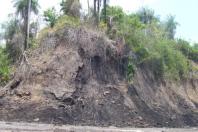Every coin has two sides
Every coin has two sides
UB Post
October 13, 2013
By B.Khash-Erdene
Mongolia has always been dependent on foreigners for fuel and petroleum goods. Although considerable deposits of oil have been discovered and extracted, Mongolia is no closer to refining and using them than it was five or ten years ago. But the talk of new horizons for Mongolia’s fuel independence and further prospects have risen in the public and media with the recent discoveries of oil shale and its potential for fuel and energy.
Although the news of oil shale as a potential replacement for conventional coal and petroleum based fuel is fairly recent, oil shale is nothing new to the mineral resource sector, physicians, chemists and some economists. There has been plenty of debate on the prospects of its use while other energy and fuel sources are still present, which are easier to exploit and more efficient than oil shale.
In truth, oil shale has been used even as far back as the mid-20th century. For instance Spain and other western nations utilized shale oil extracted from open seams by distilling them, in 1930.
Oil shale has been widely used in countries with a scarce supply of petroleum, natural gas and other valuable minerals, but since the fuel extracted from oil shale is low in quantity and quality alike, and the cost of the refining process is high, there has been little use of it in countries with easier access to more common fuel and energy sources.
The method for extracting fuel from shale has been put on hold for a long time by many countries because the process is complicated and environmentally inefficient, requiring large amounts of water and producing large amounts of waste, and it is not very economically fruitful.
Although the use of oil shale is being discussed among scientists and scholars in Mongolia, progress on its development has not exceeded a few studies on the matter. The method of extraction has not been introduced to Mongolia, and since there are plenty of coal reserves in the country, the use of shale (which has a low combustion rate) has been given the backseat.
The President of the Mongolian Shale Association, Da.Ganbold, stated, “To tell the truth, to reach the coal seam, soil used to be removed along with it, which caused a lot of ash and waste when used in a power plant. Since shale is even less caloric than conventional brown coal, and the transportation costs are much higher, it has largely been neglected and seen as wasteful… Not only this, some coal mining and exploration companies label lands unviable when shale stones are found in the drillings. They don’t even mention the finding of shale in their reports. Because of these careless operations, shale findings and deposits have not been properly recorded and studied.”
In truth, it can be said that studies on shale oil have not been conducted at all. Since exploration has not been conducted, estimating the amount of deposit is not possible. The reserve amounts hypothesized today are based on estimation methods of Russian geologists during socialist times, when Eastern Europe was united.
The Shale Association stressed that large deposits of shale stones and oil need to be identified before everything else can unfold. Not only that, but they claimed that it would be possible to conduct exploration and extraction work in areas whose licenses are for other mineral resources. Since the method of extraction is different from other mineral resource extraction, it can be done while other mining operations are active.
More good news related to shale has been reported by the Shale Association, who claims to have received good evaluations from the shale samples they sent to U.S. laboratories for tests. “The evaluations were all very positive and concluded that they were the highest quality shale. They were also low in ammonite, which suggests good quality shale,” the association said.
A shale association specialist explained how shale is formed. He said that with the changes in climate and environmental conditions, some plants in the environment are unable to adapt to new conditions, causing them to rot and decompose under exposure to low air pressure and humidity, forming peat.
The peat then changes into brown coal as it subject to high pressure underground. This process takes around 55 million years according to scientists. After a long period of time, the oxygen and air inside the peat are lowered and the rate of carbon increases, resulting in the transition from peat to coal. After an even longer period of time, and repeated exposure to high pressure and temperatures, it hardens into stone coal, and anthracite.
The plant which grows with the help of sunlight turns into hard coal fuel after a tremendous geological period. During this time, it preserves all the solar energy within itself, and when it combusts, the reserved energy is released in the form of light and heat. Five to six hundred meters below the ground, it is cauterized and refined into petroleum.
The above process is similar to the method used for extraction. The simplest way to understand the process is to look at it as a speeding up of what occurs naturally.
The extraction method uses shafts that conduct heat at a temperature of above 400 degrees Celsius for long periods of time, sometimes even months, which heats the shale stones, causing it to perspire gas and oil, similar to tar sands extraction. When shale that is underground with no access to air is heated, it perspires oil which is extracted through a pump.
Reports have been circulating that U.S. energy giant Genie has been making moves to develop oil shale exploration with the government, which has been going well. They have already signed an exclusive oil shale development agreement to explore and evaluate the commercial potential of oil shale resources on a 34,470 square kilometer area in Central Mongolia.
“We started evaluating Mongolia’s oil shale deposits after signing a joint survey agreement in 2012, and are very pleased to continue that work under this new agreement. Our geological team has located a world-class resource and will now identify the most advantageous areas for future commercial development,” said Claude Pupkin, CEO of Genie Energy in April after the agreement was reached.
O. Erdenebulgan, Mongolia’s Vice Minister of Mining, said, “Utilizing Mongolia’s extensive oil shale reserves to reduce our dependence on imported oil is a strategic priority for the government. We have been impressed by Genie’s commitment to Mongolia. They have the appropriate technical expertise to produce oil and gas from oil shale in an environmentally sensitive manner. We look forward to continuing to work with their team.”
The plan is to start producing fuel from oil shale with fifteen years. The move could potentially save Mongolia from its total dependence on imported fuel, whose price is volatile and a threat to the sustainable and stable economic and social development of the country. Mongolia currently imports 90 percent of its petroleum needs from its neighbors. Estimates have put Mongolia’s oil shale reserves at 800 billion tons or more.
On the surface it seems like a terrible waste not utilize this resource that has the potential to improve the country’s economy substantially, but on the other hand, the method of exploration, by heating soil to more than 400 degree Celsius for prolonged periods of time cannot be good for the environment. And environmental activists agree.
According to the Center for Biological Diversity, the development of “oil shale” (not to be confused with “shale oil”) and “tar sands” has been shown to be environmentally destructive, and water and energy intensive. Extracting oil from U.S. public lands through oil shale or tar sands would deal a disastrous blow to any hope of reducing atmospheric CO2 levels to below 350 parts per million — the level we need to reach soon to stabilize Earth’s climate. Besides helping push us towards a global warming catastrophe, oil shale and tar sand development destroys wildlife habitats, wastes enormous volumes of water, pollutes air and water, and degrades and defiles vast swaths of land.
The Diplomat, a Tokyo-based, online current affairs magazine covering politics, society and culture in the Asia-Pacific said, “Oil shale is even worse than the tight oil [shale oil] extracted with fracking. The resource has a very low energy density, so much energy and effort have to be expended in extraction and upgrading each unit of output. The tar sands of Canada offer an analogy, but oil shale is an even lower-grade resource.”
In short, on the one hand we have the economy, and in the other we have the environment and we cannot have both with the “oil shale revolution”. This is nothing new to Mongolia with its vast mining resources. It’s an age old dilemma and the needs of the economy seem to be prevailing over the needs of the environment at the moment, with so many mining activities already operating in the country. Since oil shale is new to Mongolia, more study and research into the matter has to be made before it jumps into a long term agreements. Clearly the coin has more than one side.
Short URL: http://ubpost.mongolnews.mn/?p=6299


